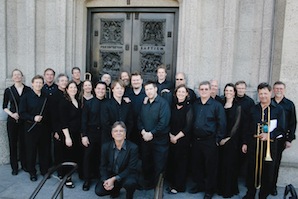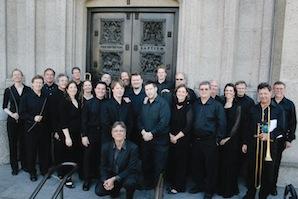Although many arts organizations capitalize on the holidays to throw together friendly (and underrehearsed) programs of familiar music, Christmas has long inspired the vivid imagination of composers and performers through a wealth of excellent music. It was heartening, therefore, to see Berkeley’s First Congregational Church filled Saturday night to hear a reconstruction of a 1660 Christmas Vespers at the Dresden Court Chapel through a festive collaboration between the early-music ensembles Magnificat, the Whole Noyse, and the Sex Chordae Consort of Viols. At the center of the program, presented under the San Francisco Early Music Society umbrella, was Heinrich Schütz’s Weihnachtshistorie (Christmas Story) and Francesco Cavalli’s 1656 Magnificat.

The assemblage of 13 instrumentalists and eight male singers onstage approached choral-orchestral proportions, but that challenged the standard complement of a Baroque orchestra. In place of violas and cellos, there were tenor and bass viols; for trombones, sacbuts; for flutes, recorders; for a bassoon, a dulcian; and, coming in last as the most exotic, a pair of cornets. With so many specialists, the tonal color of the instruments and their balance within the ensemble made a tremendous impact on the sound. The duet for tenor viols (played by David Morris and Julie Jeffrey), supporting the Angel speaking to the Shepherd in the fields, is impossible to replicate with other instruments.
This expansion of forces caused a few minor growing pains. In First Congregational’s acoustic, Artistic Director Warren Stewart needed to place the singers in front of the instrumentalists to achieve ample vocal presence. Working out such logistics is a unique challenge to ensembles that have limited time to adapt their programs for multiple locations on successive nights (Palo Alto, then San Francisco, and so on). And traditional church music often ignores audience sightlines.
The tonal color of the instruments and their balance within the ensemble made a tremendous impact on the sound.
I missed Magnificat’s excellent roster of female singers. Male falsetto singing is an imperfect substitute for the castratos and choirboys of Schütz’s and Cavalli’s day. Although the lower falsettists held their own on Saturday, the music clearly pushed the limitations of the sopranists’ technique. This especially affected countertenor Andrew Rader, who had to cope with getting through numerous challenging solos, singing high exposed lines, and projecting over a larger-than-usual band. This challenge extended to choral balance as well, when countertenors could not keep up with such basses as Peter Becker, who filled the room with his rich, demonic portrayal of Herod.
Listeners, Awake
Lower-voice singing excelled throughout the evening, especially in a trio for Wise tenors and a quartet of High Priest baritones. In this latter section, Schütz made tribute to his own patrons through unnecessary lengthening of a biblical passage justifying aristocratic rule. The prominence of the word Herzog (meaning duke, like the Saxon rulers of Dresden: originally, Herzogtum Sachsen) bordered on the comical. The evening’s music included an abundance of madrigalisms: word painting such as a blunt orchestral tutti on the word omnes (all) or the fa-la-la dispersit (scattered) in Cavalli’s Magnificat. The suscepit israel sounded as if it could have come right out of Monteverdi’s collections of sacred music from the 1640s. It also occurred to me that the surprising chromatic harmonies in works like Schütz’s Vater Unser have an additional purpose in church music other than the play-by-play emotion of the madrigal school: to prevent boredom and keep one’s focus on the text and service.
Like the Bach “Passions,” the Schütz Weihnachshistorie contains a lengthy part for a tenor evangelist. Very light baritone Martin Hummel sang this from memory. This was less impressive for me than for the audience, because I had sung it before, but I also found it out of place when everyone else performed on book. In the context of the concert’s liturgical reconstruction, the music took the place of a gospel reading and sermon (in its time, often one by Martin Luther), which are also read from books. There is a tradition of “pretend reading” in oratorios and similar works, but the tradition extends to modern Catholic Masses where the priest ostentatiously appears to read the creed even though he knows it by heart. Hummel, who is German, sings with a bit of a lisp, which I attribute to a Badisch dialect.
Filling out the concert was an opulent setting of Psalm 122 by Vincenzo Albrici (1631–1695), one of many Italians working for the Dresden musical establishment, along with a few interspersed Lutheran chorales. The religious elements of the program provided ample context to better understand the music without going too far in turning the concert into a church service, as has occasionally been one of Magnificat’s faults. This was especially informative because listeners rarely encounter Lutheran vespers these days. Even the music of that tradition is infrequently performed among professional early-music ensembles. The straitjacket of standing forces in modern period-instrument orchestras limits modern opportunities to hear works from the 17th century, thus reducing our understanding of how the music of Schütz and his contemporaries influenced familiar repertory works of later times.

